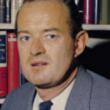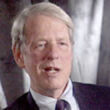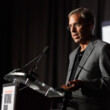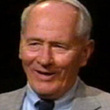Freedom's Forge: How American Business Produced Victory in World War II
(Libby/OverDrive eAudiobook)
Available Platforms
Description
More Details
Excerpt
Similar Titles From NoveList
Similar Authors From NoveList
Published Reviews
Booklist Review
A narrative of America's industrial mobilization for WWII, Herman's history heroizes two business executives at the center of affairs, Henry Kaiser, builder of the Liberty ships, and William Knudsen, president of General Motors. While Kaiser's hyperkinetic flamboyance lingers in the recognition his name still provokes in WWII readers, the more effacing Knudsen, Herman makes clear, was the critical character. An expert in organizing assembly lines, Knudsen was tapped by FDR in 1940 to convert consumer into military production, which he initiated through private enterprises. New Dealers who wanted the government, not big business, to direct mobilization nominally won in early 1942 by ousting Knudsen and establishing the War Production Board. But Knudsen's profit-motive template had momentum and prevailed, as Herman dramatizes in the manufacturing setups for such weapons as the B-24 and B-29 bombers, Sherman tanks, and aircraft carriers. What with the millions of workers needed to build them, Rosie the Riveter included, swarming factory floor and shipyard, Herman's story will resonate with readers whose parents and grandparents won the war with a welding torch.--Taylor, Gilbert Copyright 2010 Booklist
Publisher's Weekly Review
Herman (How the Scots Invented the Modern World) tells the epic story of the American businessmen who, in only a few years, helped America become the largest military power in history. These include William Knudsen, a Danish immigrant who turned General Motors into "the largest industrial corporation in the world," and industrialist Henry Kaiser, the "master builder" responsible for infrastructure projects throughout the country. In 1940, Roosevelt personally called upon Knudsen to oversee the assignment of contracts worth billions of dollars to produce the guns, tanks, planes, and other equipment needed for battle. Eschewing centralization in favor of free-market incentives, Knudsen directed the forging of "'the arsenal of democracy,'" as factories around the nation converted to wartime production. Kaiser, meanwhile, presided over the creation of a new navy, America's "Liberty ships," which Churchill called "the foundation of all our hopes." At times, the book falls into not-so-subtle hagiography of American capitalists, who are portrayed as selfless patriots who succeed despite the efforts of opportunistic labor organizations and big government New Dealers hostile to the free market. However, Herman has a knack for generating both suspense and patriotic self-congratulation. A cross between Ayn Rand, Herman Wouk, and the Wall Street Journal, the book is a compulsively readable tribute to "the miracle of mass production." Agent: Glen Hartley, Writers Representatives. (May) (c) Copyright PWxyz, LLC. All rights reserved.
Library Journal Review
What is covered in most textbooks in a page-the crucial role of American industry in winning World War II-takes up the entirety of Herman's (Gandhi & Churchill: The Epic Rivalry That Destroyed an Empire and Forged Our Age) fascinating volume. As he has in past books, Herman here approaches a chapter of history by investigating the personalities who shaped it. He brings to life William Knudsen of General Motors and shipbuilder Henry J. Kiser via their interactions with FDR. It would be easy to overwhelm readers with recountings of the extraordinary number of planes, ships, or tanks produced. However, Herman will keep his audience thoroughly engaged as the war unfolds from the perspective of U.S. industry and its regulators. At a time when Wall Street is often pitted against Main Street, readers will be surprised by the cooperative relations forged between government and industry during World War II. VERDICT Recommended for the invaluable insights regarding how government administrators and industry leaders worked together to produce a winning arsenal. Economists and general readers alike will benefit from its historical perspective.-Jekabs Bikis, Dallas Baptist Univ., TX (c) Copyright 2012. Library Journals LLC, a wholly owned subsidiary of Media Source, Inc. No redistribution permitted.
Kirkus Book Review
It's not often that a historian comes up with a fresh approach to an absolutely critical element of the Allied victory in World War II, but Pulitzer finalist Herman (Gandhi Churchill: The Epic Rivalry that Destroyed an Empire and Forged Our Age, 2009, etc.) has done just that. The author argues powerfully against the conventional wisdom that America's rearmament took place under the guidance of a competent federal government that brought business and labor together for the country's defense. To the dismay of New Dealers who had hoped to use the war to bring business under government control, the production of the flood of war materiel that drowned the Axis was achieved by the voluntary cooperation of businesses driven as much by the profit motive as by patriotism, solving problems through their own ingenuity rather than waiting for government directives. The physical and organizational challenges were overwhelming. The production of sufficient familiar armaments required expanding existing moribund plants and constructing new ones, then manufacturing new machine tools and organizing their use to maximize efficiency. Doing the same for enormously complex new weapons, in particular the B-29 bomber with 40,000 different parts made by 1,400 subcontractors, was an even more staggering task, exacerbated by materials shortages and recalcitrant labor unions. A story resting on the statistics of industrial production runs a constant risk of lapsing into tedium, but Herman's account never falters. He carries it off in engaging style by centering this sweeping narrative on the efforts of two colorful business leaders, Henry Kaiser and William Knudsen, who led the struggle to produce ships, planes and arms for Britain and then for America in a war that many had persisted in believing wasn't coming. A magnificent, controversial re-examination of the role of American business in winning WWII.]] Copyright Kirkus Reviews, used with permission.
Booklist Reviews
A narrative of America's industrial mobilization for WWII, Herman's history heroizes two business executives at the center of affairs, Henry Kaiser, builder of the Liberty ships, and William Knudsen, president of General Motors. While Kaiser's hyperkinetic flamboyance lingers in the recognition his name still provokes in WWII readers, the more effacing Knudsen, Herman makes clear, was the critical character. An expert in organizing assembly lines, Knudsen was tapped by FDR in 1940 to convert consumer into military production, which he initiated through private enterprises. New Dealers who wanted the government, not big business, to direct mobilization nominally won in early 1942 by ousting Knudsen and establishing the War Production Board. But Knudsen's profit-motive template had momentum and prevailed, as Herman dramatizes in the manufacturing setups for such weapons as the B-24 and B-29 bombers, Sherman tanks, and aircraft carriers. What with the millions of workers needed to build them, Rosie the Riveter included, swarming factory floor and shipyard, Herman's story will resonate with readers whose parents and grandparents won the war with a welding torch. Copyright 2012 Booklist Reviews.
Library Journal Reviews
Pulitzer Prize finalist for Ghandi & Churchill, Herman here presents businessmen as the good guys, showing how two in particular—Danish immigrant William Knudsen and shipbuilding magnate Henry Kaiser—pummeled businesses around the country to build what was needed for the war effort. The result? Service to democracy and the creation of the military-industrial complex. Not just for history fans.
[Page 50]. (c) Copyright 2012. Library Journals LLC, a wholly owned subsidiary of Media Source, Inc. No redistribution permitted.Library Journal Reviews
What is covered in most textbooks in a page—the crucial role of American industry in winning World War II—takes up the entirety of Herman's (Gandhi & Churchill: The Epic Rivalry That Destroyed an Empire and Forged Our Age) fascinating volume. As he has in past books, Herman here approaches a chapter of history by investigating the personalities who shaped it. He brings to life William Knudsen of General Motors and shipbuilder Henry J. Kiser via their interactions with FDR. It would be easy to overwhelm readers with recountings of the extraordinary number of planes, ships, or tanks produced. However, Herman will keep his audience thoroughly engaged as the war unfolds from the perspective of U.S. industry and its regulators. At a time when Wall Street is often pitted against Main Street, readers will be surprised by the cooperative relations forged between government and industry during World War II. VERDICT Recommended for the invaluable insights regarding how government administrators and industry leaders worked together to produce a winning arsenal. Economists and general readers alike will benefit from its historical perspective.—Jekabs Bikis, Dallas Baptist Univ., TX
[Page 86]. (c) Copyright 2012. Library Journals LLC, a wholly owned subsidiary of Media Source, Inc. No redistribution permitted.Publishers Weekly Reviews
Herman (How the Scots Invented the Modern World) tells the epic story of the American businessmen who, in only a few years, helped America become the largest military power in history. These include William Knudsen, a Danish immigrant who turned General Motors into "the largest industrial corporation in the world," and industrialist Henry Kaiser, the "master builder" responsible for infrastructure projects throughout the country. In 1940, Roosevelt personally called upon Knudsen to oversee the assignment of contracts worth billions of dollars to produce the guns, tanks, planes, and other equipment needed for battle. Eschewing centralization in favor of free-market incentives, Knudsen directed the forging of "‘the arsenal of democracy,'" as factories around the nation converted to wartime production. Kaiser, meanwhile, presided over the creation of a new navy, America's "Liberty ships," which Churchill called "the foundation of all our hopes." At times, the book falls into not-so-subtle hagiography of American capitalists, who are portrayed as selfless patriots who succeed despite the efforts of opportunistic labor organizations and big government New Dealers hostile to the free market. However, Herman has a knack for generating both suspense and patriotic self-congratulation. A cross between Ayn Rand, Herman Wouk, and the Wall Street Journal, the book is a compulsively readable tribute to "the miracle of mass production." Agent: Glen Hartley, Writers Representatives. (May)
[Page ]. Copyright 2012 PWxyz LLCReviews from GoodReads
Citations
Herman, A., & McDonough, J. (2012). Freedom's Forge: How American Business Produced Victory in World War II (Unabridged). Recorded Books, Inc..
Chicago / Turabian - Author Date Citation, 17th Edition (style guide)Herman, Arthur and John McDonough. 2012. Freedom's Forge: How American Business Produced Victory in World War II. Recorded Books, Inc.
Chicago / Turabian - Humanities (Notes and Bibliography) Citation, 17th Edition (style guide)Herman, Arthur and John McDonough. Freedom's Forge: How American Business Produced Victory in World War II Recorded Books, Inc, 2012.
Harvard Citation (style guide)Herman, A. and McDonough, J. (2012). Freedom's forge: how american business produced victory in world war II. Unabridged Recorded Books, Inc.
MLA Citation, 9th Edition (style guide)Herman, Arthur, and John McDonough. Freedom's Forge: How American Business Produced Victory in World War II Unabridged, Recorded Books, Inc., 2012.
Copy Details
| Collection | Owned | Available | Number of Holds |
|---|---|---|---|
| Libby | 3 | 0 | 5 |

































